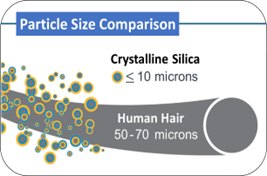- Crystalline silica (airborne particles of respirable size) is on the Proposition 65 list for cancer. Exposure to crystalline silica can cause cancer of the lung.
- California’s Proposition 65 requires businesses to warn people before exposing them to a significant amount of a chemical listed under Proposition 65 for cancer or reproductive toxicity.
Silica or silicon dioxide (SiO2) is a mineral that makes up about 60% of the Earth’s crust. Silica can come in two forms: amorphous or crystalline. Common types of crystalline silica include quartz and cristobalite.
The only form of crystalline silica on the Proposition 65 list consists of airborne particles measuring 10 micrometers or less (about one-seventh the thickness of a human hair), which can be inhaled.
Crystalline silica is present in rocks, including quartzite, granite, marble, limestone, and sandstone.
It is also present in building materials such as sand, cement, concrete, bricks, mortar, manufactured or engineered stone, glass, ceramic, plaster, and wood filler.
Sandblasting, as well as cutting, grinding, sanding, or polishing these materials can release particles of crystalline silica of respirable size into the air.
These tiny particles may also be present in certain products such as some paints, pottery glazes, and dry or powdered art clays.

This picture shows how small crystalline silica particles of respirable size are, compared to a strand of human hair.
Image adapted from the California Air Resources Board, California Environmental Protection Agency
- Work outside, if possible, when you are cutting, grinding, sanding, or using abrasive materials to polish quartzite, granite, marble, manufactured or engineered stone, or other materials that contain crystalline silica.
- Use wet methods to cut, grind, or sand these materials, if possible.
- Wear a respirator, and learn how to use it effectively.
- Take the same precautions, if possible, when sanding surfaces that may contain crystalline silica, such as those with plaster, paint, or wood filler.
- When working with dry or powdered art clays and glazes that contain crystalline silica, avoid actions that can unnecessarily release the materials into the air, especially indoors.
- For example, if you need to shake out a table covering or garment after using these art materials, do so outdoors.
- Do not use brooms, blowers, fans, or compressed air to move powder or dust that contains crystalline silica.
- Vacuum up dust using a vacuum cleaner with a high efficiency particulate air (HEPA) filter, or use a shop vacuum cleaner with a HEPA filter, if possible.
- Use wet clean-up methods, such as removing dust with wet rags.
- Change out of clothes that contain particles of crystalline silica before entering your home, car, or other enclosed areas.
- Minimize children’s exposure to work areas where dust containing crystalline silica may be present.
General Fact Sheets and Resources
- Centers for Disease Control and Prevention (CDC)
- National Cancer Institute
- Agency for Toxic Substances and Disease Registry (ATSDR)
- US Department of Labor
Occupational Safety and Health Administration (OSHA) - California Department of Industrial Relations (DIR)
- California Department of Public Health (CDPH)
Scientific Information on Crystalline Silica
- World Health Organization (WHO)
International Agency for Research on Cancer (IARC)- IARC Monographs on the Evaluation of Carcinogenic Risks to Humans, vol. 100C (2012). “Silica Dust, Crystalline, in the Form of Quartz or Cristobalite” in Arsenic, Metals, Fibres, and Dusts, pages 355-405.
Proposition 65
- California Environmental Protection Agency (CalEPA)
Office of Environmental Health Hazard Assessment (OEHHA)- Proposition 65: Background
- Proposition 65: The List of Chemicals
- Proposition 65: Fact Sheets
